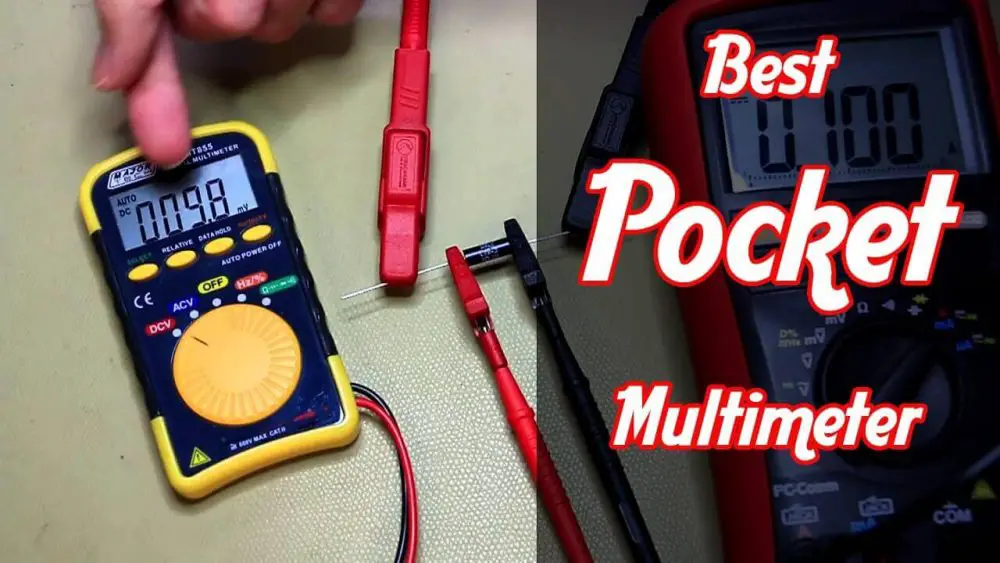How to use a multimeter to test voltage of live wires
Operating with live wires is always risky. Would you please exercise absolute care when examining them? If the cables are exposed, make sure they do not come intact. It is also good to switch off the power until you are ready to test for voltages.
A multimeter is the most helpful device for examining the voltage of live wires. The multimeter tells you that the wires are live, meaning there is some current flowing through them, and it tells you how much voltage is present. It can also help diagnose an electrical problem or check that an outlet or switch is working correctly.
In this article, you will learn more about using a multimeter to test the voltage of live wires.
Check if the Wires are Live
Before you test voltage, examine if the wires are live. Use a voltage tester. A non-contact voltage tester is an excellent choice, especially for cables concealed behind insulation or sockets.
When the wires are open, or you may be intact with the metal terminals, you must use a contact voltage tester.
But a voltage tester does not tell you the precise amount of voltage. It only measures if there is any flowing current or voltage at all by turning it on. Some voltage testers also provide a buzz or chirp sound to recognise the live wire.
When you observe the wires are alive, now you can use a multimeter to measure the voltage.

Table of Contents
Setting up the Multimeter
Step 1: Safety
When dealing with a live wire or electrical instrument, safety is predominant. Therefore, it would be best to consider safety more than ever when dealing with A/C current as high as 120 or 220 Volts.
When using an HVAC multimeter for electrical and electronic devices, follow the general safety precautions, like not encountering a live wire with your bare hand. Likewise, if you must move the cable, make sure you are wearing an insulating glove.
Additionally, ensure to switch the multimeter from D/C to A/C settings whenever you require to measure an electrical value in an A/C current circuit. Lastly, ensure you always set up your testing with the highest voltage or current range on your multimeter selector.
Step 2: Set the Parameter to Voltage
Besides, set the selection dial to the voltage setting. Then, you can use the multimeter to measure the voltage, current, and resistance, as we said earlier. A typical multimeter can measure voltages within the range of 200 mV to 600 V A/C or D/C.
The multimeter voltage selection uses the part labelled V and a straight line to measure D/C voltage. Likewise, use the region labelled V and a wavy line to measure A/C current.
Where you select to place the dial determines the accuracy of your reading. So, if you require to test the voltage of your home socket, which is typically 220 V or 110 V in some countries, set the selection dial to A/C position.
Step 3: Plug in the Probes
After setting the selection dial accurately according to the type of current and measurement of voltage, you need to plugin the multimeter probes in the appropriate ports. Multimeters have two, three, or four ports depending on the type of multimeter.
If you hold a classic three-port multimeter, it will come with a COM port, a mAVΩ port, and a 10A port. Only use the 10 Amp port when measuring very high current values.
Conventionally, the COM means Common port, and it is where you plug in the black probe, which you almost always connect to the circuit’s negative wire or ground wire. The mAVΩ port allows you to measure resistance, voltage, and current up to 200 mA.
Nevertheless, there is no difference between the red and black probes. So plug the probes into the COM and mAVΩ ports when you want to measure the voltage.
Step 4: Using the Probes
Now you set up all your probes into a multimeter, and you can proceed to the present testing. To ensure everything is set correctly, you might require testing the multimeter on a highly live wire you are sure is working.
Place the red probe on the live exposed wire and the black cable on the neutral wire, and ultimately the reading will appear on the screen. Of course, you can also put the black wire on the earth wire and the red on the Live Wire, so you will still get a reading.
After testing and making sure it works well, you can check any other live wire you want to test. Note that nothing unfortunate will happen if you twist the black and red wire.
If you twist it by mistake, your voltage reading will become a negative number of the actual reading. This negativity is because a multimeter measures the voltage of a live wire to the common (COM) port makes no difference.
Step 5: Taking Your Reading
There is no voltage on the screen if you get a zero reading after testing the live wire. In other words, no current is flowing through the wire.
You can find the power source to fix the issue if you know your way around the electrical wiring, but if you do not, please call an electrician for support.
Testing Voltage For a Socket
If the live wires connect to a plug socket, it is easy to test the voltage.
Insert one lead into the neutral left slot of the socket and the other lead into the live right slot. Check the reading on the multimeter.
If everything is correct, the wires should be conducting a voltage of 230V, though it can be slightly lower or higher.
You can test the voltage of the neutral wire by using the multimeter. Plug one of the multimeter leads into the ground/earth terminal (the hole at the top), and the other lead into the left terminal.
Check the multimeter reading for voltage. If the socket is wired correctly, it should read zero or close to zero. If it is larger than zero, then there must be a wiring problem.
If it is 230V or close, it may convert the socket wiring.
Testing voltage For a Switch
If the live wires directly to a switch, unscrew the switch to access the exposed terminals.
Make sure the switch is on; touch one multimeter lead on the ground wire or terminal and the other lead on one of the live wires. And observe the voltage reading.
While holding one lead on the ground terminal, touch the second lead onto the other live terminal or wire.
Similarly to a socket plug, the live wires of a switch both read 230V or thereabouts.
Testing Voltage For an Exposed Wires
You can also measure the voltage of live exposed wires. But, again, you should be extra careful.
When we measure the voltage of each wire, touch one of the multimeters lead on any metal body or the screw nearby. For example, it could be a radiator or a metal pipe. This object will act as the ground reference.
Touch the second multimeter lead on each of the exposed wires and check the voltage of each wire.
In the 3-wire circuits at home, only one wire would register a voltage of about 230V. Therefore, this wire must be the live wire.
The ground and neutral wires should indicate a voltage of zero or close to zero.
If you don’t have a metal object nearby to use as a ground reference, you can measure the voltage difference across the wires.
Measure the neutral wire and live wire to get the voltage of the live wire (use the sheath colours to identify which wires are neutral, live and earth). Measuring earth wire and a live wire also gives you the voltage of the live wire.
Measure the ground and neutral to see if there’s any voltage in the neutral wire.
Cautions of Checking the Voltage of Live Wire?
When working on an electric circuit, there is a risk of electrical accidents. For example, when a body comes in contact with a live wire, current flows through the body to the earth. This flow can cause serious injuries or even death in some cases.
As a matter of safety, it is best always to wear safety rubber gloves when handling electricity. Also, while managing a multimeter, do not let the probes short circuit because it will create a large spark.
Also, be cautious not to work on a live wire with wet hands. Water can partly conduct electricity, which can cause a hazard. If you have a tester screwdriver, you can use it to test if there is current on the wire before using a multimeter to measure how much voltage is passing through.
By doing so, you would be extra careful as the tester screwdriver will flashlight if the current is flowing in the wire.
Why is it Important to Check the Voltage of a Live Wire
Examining the Voltage of live Wire is necessary for several reasons. Here are three of the most prominent and most important reasons:
To Ensure the Power Supply Works Perfectly
People use a multimeter to measure the amount of voltage flowing through a wire. You can determine how much voltage is passing through the wire and compare it to the expected voltage.
An insufficiency in the amount of voltage supplied compared to the predicted voltage tells you there is a problem along the supply line.
To Prevent Hazard
You may stop hazards when you know there is current present in a live wire. First, use a multimeter to check for the voltage of a live wire to be sure. Then, if there is current in the live cables, take measures to prevent danger as such wires could cause hazards.
To Fix a Problem
The different reason people check the voltage of a live wire is to fix a problem. For example, a digital multimeter can tell you the voltage supplied to a malfunctioning socket.
By identifying the amount of voltage provided to it, you can quickly diagnose the problem and be ready to fix it.
Frequently Asked Questions
The best way to test for a live electrical wire safely, use either a non-contact voltage tester or a digital multimeter. A non-contact voltage tester is the safest way for testing live wires, performed by placing the tool near the wire will be a flashlight to show the wire is alive.
Place the black probe of the multimeter on the black wire and the red probe on the bare metal on the end of a white wire, then read the meter. If you get a reading, it means the black wire is hot; if you do not get a reading, the black wire is not hot.
Conclusion:
In conclusion, a multimeter is a fundamental tool in the stockpile of any electronic enthusiast. A multimeter gives you the ability to do more than measuring the voltage; you may also measure the amperage and resistance across wires.
Also, keep it at the back of your mind that electricity can be hazardous. If you have reservations about your capacity to measure the voltage of a live wire, make sure you consult a qualified electrician.
Related Posts:
How to Test Purge Valve with Multimeter





